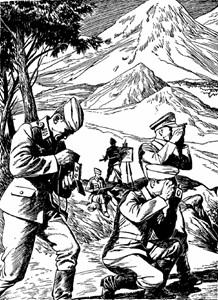 In the course of researching the Now the Hell Will Start chapter that deals with wartime prostitution, we stumbled upon a great little artifact called Morale-Building Activities in Foreign Armies. It’s an illustrated 1943 pamphlet that delves into the various methods used by both Axis and Allies to pep up their troops’ spirits. And it makes fighting history’s most lethal war seem like attending Camp Pinewood.
In the course of researching the Now the Hell Will Start chapter that deals with wartime prostitution, we stumbled upon a great little artifact called Morale-Building Activities in Foreign Armies. It’s an illustrated 1943 pamphlet that delves into the various methods used by both Axis and Allies to pep up their troops’ spirits. And it makes fighting history’s most lethal war seem like attending Camp Pinewood.
The illustration at right, for example is captioned: “German soldiers who are artistically inclined are allowed to bring cameras and art kits into the theater of operations.” And the Italians really seemed to have a ball when the guns fell silent:
A specific Fascist unit organization furnishes music and entertainment for soldiers. Singing is probably the most popular diversion for Italians in camp or on the march. Both individual and group singing is encouraged and stimulated by the army. In an official handbook on “Life in the Garrison” (Norme della vita di caserne), it is stated that “Songs and patriotic hymns should form an important element in the soldier’s life.” Another official publication, “Rules of Instruction” (Regolamento d’instruzione), includes a statement that the “Italian soldier, in addition to fighting, eats and sings.”
The stick-in-the-mud award goes to the British, who were the lone non-American force to actively discourage liaisons with prostitutes. A British soldier’s free nights were instead meant to be filled with “plenty of healthy interests and amusements.” Sounds painfully dull, but you really can’t question the resulting won-loss record.


Jordan // May 5, 2009 at 6:30 pm
The important question: were those activities better or worse than getting to play XBox today?
Brendan I. Koerner // May 5, 2009 at 10:09 pm
@Jordan: Probably worse, at least in terms of encouraging pure martial spirit. Fallout 3 would totally have gotten me amped to slog up the Italian Peninsula, circa 1943.